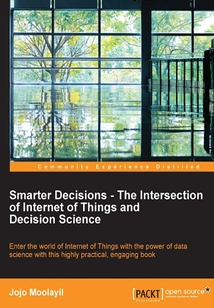首頁 > 計算機網絡 >
編程語言與程序設計
> Smarter Decisions:The Intersection of Internet of Things and Decision Science最新章節目錄
舉報 

會員
Smarter Decisions:The Intersection of Internet of Things and Decision Science
最新章節:
Summary
IfyouhaveabasicprogrammingexperiencewithRandwanttosolvebusinessusecasesinIoTusingdecisionsciencethenthisbookisforyou.Evenifyour'reanon-technicalmanageranchoringIoTprojects,youcanskipthecodeandstillbenefitfromthebook.
目錄(76章)
倒序
- 封面
- 版權頁
- Credits
- About the Author
- About the Reviewer
- eBooks discount offers and more
- Why subscribe?
- Preface
- What this book covers
- What you need for this book
- Who this book is for
- Sections
- Conventions
- Reader feedback
- Customer support
- Chapter 1. IoT and Decision Science
- Understanding the IoT
- Demystifying M2M IoT IIoT and IoE
- Digging deeper into the logical stack of IoT
- The problem life cycle
- The problem landscape
- The art of problem solving
- The problem solving framework
- Summary
- Chapter 2. Studying the IoT Problem Universe and Designing a Use Case
- Connected assets & connected operations
- Defining the business use case
- Sensing the associated latent problems
- Designing the heuristic driven hypotheses matrix (HDH)
- Summary
- Chapter 3. The What and Why - Using Exploratory Decision Science for IoT
- Identifying gold mines in data for decision making
- Exploring each dimension of the IoT Ecosystem through data (Univariates)
- Studying relationships
- Exploratory data analysis
- Root Cause Analysis
- Summary
- Chapter 4. Experimenting Predictive Analytics for IoT
- Resurfacing the problem - What's next?
- Linear regression - predicting a continuous outcome
- Decision trees
- Logistic Regression - Predicting a categorical outcome
- Summary
- Chapter 5. Enhancing Predictive Analytics with Machine Learning for IoT
- A Brief Introduction to Machine Learning
- Ensemble modeling - random forest
- Ensemble modeling - XGBoost
- Neural Networks and Deep Learning
- Packaging our results
- Summary
- Chapter 6. Fast track Decision Science with IoT
- Setting context for the problem
- Defining the problem and designing the approach
- Exploratory Data Analysis and Feature Engineering
- Building predictive model for the use case
- Packaging the solution
- Summary
- Chapter 7. Prescriptive Science and Decision Making
- Using a layered approach and test control methods to outlive business disasters
- Connecting the dots in the problem universe
- Story boarding - Making sense of the interconnected problems in the problem universe
- Implementing the solution
- Summary
- Chapter 8. Disruptions in IoT
- Edge/fog computing
- Cognitive Computing - Disrupting intelligence from unstructured data
- Next generation robotics and genomics
- Autonomous cars
- Privacy and security in IoT
- Summary
- Chapter 9. A Promising Future with IoT
- The IoT Business model - Asset or Device as a Service
- Smartwatch – A booster to Healthcare IoT
- Smart healthcare - Connected Humans to Smart Humans
- Evolving from connected cars to smart cars
- Summary 更新時間:2021-07-14 10:39:25
推薦閱讀
- 現代C++編程:從入門到實踐
- 算法零基礎一本通(Python版)
- PowerCLI Cookbook
- INSTANT CakePHP Starter
- Banana Pi Cookbook
- 零基礎學Python數據分析(升級版)
- Spring Boot企業級項目開發實戰
- Java:High-Performance Apps with Java 9
- 圖數據庫實戰
- Learning Unreal Engine Android Game Development
- Hands-On Kubernetes on Windows
- Distributed Computing in Java 9
- Java Hibernate Cookbook
- 高效使用Greenplum:入門、進階與數據中臺
- Swift iOS Programming for Kids
- Learning Java Lambdas
- Implementing DevOps with Ansible 2
- Learning VMware vCloud Air
- Yii框架深度剖析
- 高性能Java架構:核心原理與案例實戰
- JSP程序設計實訓與案例教程(第2版)
- LibGDX Cross:Platform Development Blueprints
- More Effective C++:35個改善編程與設計的有效方法(中文版)
- Oracle SOA BPEL Process Manager 11gR1:A Hands-On Tutorial
- 網頁游戲開發秘笈
- GPU編程實戰(基于Python和CUDA)
- Python機器學習原理與算法實現
- Preparing for the Certified OpenStack Administrator Exam
- Scrapy網絡爬蟲開發實戰
- Getting Started with TensorFlow

